16 inch laptops are useful in many situations. They are capable, if they are well thought out and well built, of offering a good balance between screen size and portability. The MateBook D 16, for example, impressed us with its understated design, comfortable keyboard with separate numeric keypad and conveniently placed webcam. Autonomy could have been better though.
Between the MateBook 16s, successor to the MateBook 16 tested and approved earlier in the year. Unfortunately, the camera placement – which pops up from a key in the Fn row – provides an unflattering viewing angle during video calls. This problem has been solved in this new model. The 16s sits on a 12th Gen Intel Core H-series processor, has a 2.5K IPS touchscreen, and a high-capacity battery.
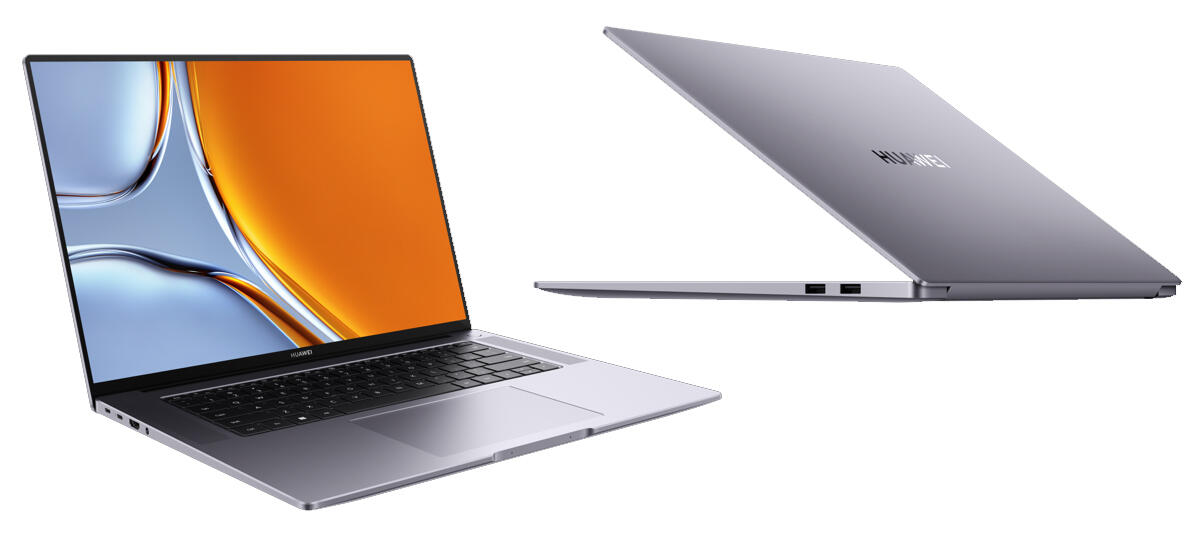
Huawei Matebook 16s – Best prices:
 Amazon
Amazon1699.00
 Baker
Baker1699.00
This all sounds very promising, but does the MateBook 16s – sold for €1,699 in France – live up to its promises in practice?
Design
The MateBook 16s very clearly comes from the same production line as the D 16. This is evidenced by its elegant and minimalist look which is based on a metallic gray aluminum chassis. Its footprint is slightly larger than the D16, despite being a little thinner (17.8mm versus 18.4mm) and weighing 290g more. But even with its 1.99 kg on the scale, it is portable enough to be taken on a trip, if not transportable on a daily basis.
The main differences between the two models become apparent when you open the hood. The latest model has a keyboard flanked on either side by speaker grilles (instead of a numeric keypad). The touchpad is also much larger. The keyboard is backlit, offers 1.5mm of travel, and is comfortable and quiet in use. Above the screen is a 1080p webcam. The power button, located in the upper right corner, incorporates a fingerprint reader.
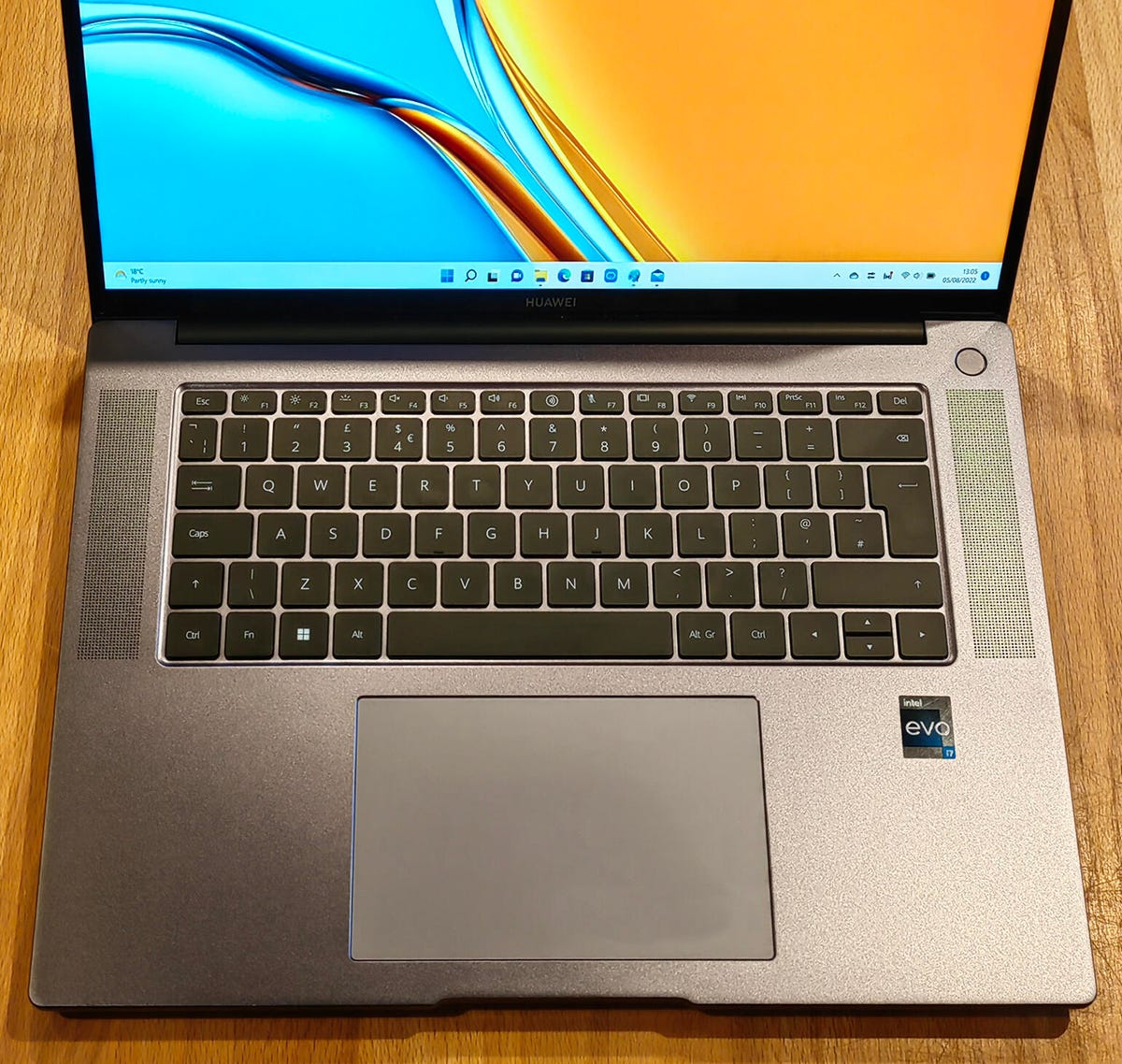
Image: Charles McLellan/ZDNet
IPS screens are also different. The MateBook 16s has a 10-point touch screen with a resolution of 2.5K (2,520 x 1,680 px, or 189 ppi) with a ratio of 3:2. The D 16 has a non-touch FHD+ panel (1,920 x 1,200 px, or 142 ppi) with a ratio of 16:10. Both displays boast a peak brightness of 300 nits and support 100% sRGB color gamut. The MateBook 16s takes advantage on contrast with a ratio of 1500:1 against 1200:1 for the D 16. Huawei also praises the high color accuracy (DeltaE < 1) of the MateBook 16s. Something to delight creatives.
Features
Our €1,699 test model was equipped with a Core i7-12700H processor. It also has 16 GB of LPDDR RAM and 1 TB of NVMe PCIe SSD storage. The GPU is an Intel Iris Xe Graphics – There is no compatibility for other graphics cards.
Wireless communication is provided by Intel’s 6E AX211 Wi-Fi module which, as its name suggests, supports the latest tri-band (2.4 GHz, 5 GHz, 6 GHz) Wi-Fi standard. Fi 6E as well as Bluetooth 5.3.
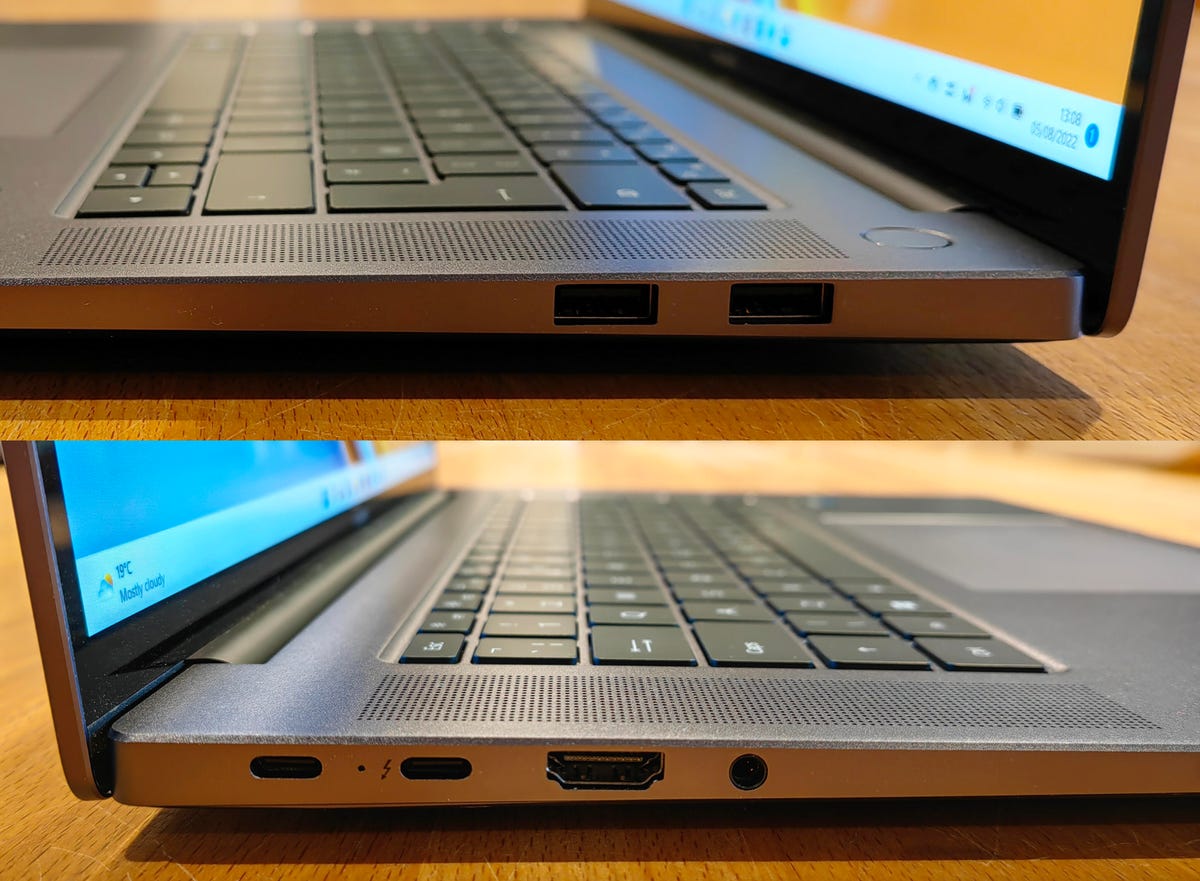
Image: Charles McLellan/ZDNet.
The computer has a good, but not flawless, selection of ports. On the left side, there are two USB-C ports. Both support data transfer, charging and DisplayPort standard. They are also Thunderbolt 4 (40Gbps) compatible. Next to it is a standard HDMI connector and a 3.5mm audio input/output jack. The right side houses two USB-A ports with support for USB 3.2 Gen 1 (5 Gbps). Unfortunately, although SD or MicroSD card slots are becoming more common, you won’t find any here. Too bad for photographers who want a machine for editing.
The MateBook 16s packs an 84Wh battery – a huge step up from the MateBook D 16’s 60Wh – to support the high-resolution display and more powerful processor.
Performance and autonomy
The MateBook 16s’ 14-core Core i7-12700H processor scored 1840 (single core) and 9715 (multi core) on Geekbench 5. A score comparable to what we recorded on the 16-inch MacBook Pro M1 Max, namely 1790 (single core) and 12780 (multi core).
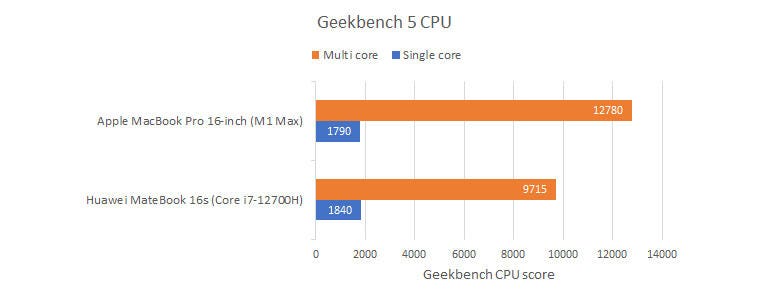
Graphic: Charles McLellan/ZDNet.
On PCMark 10, the MateBook 16s obtained an overall score of 5628. This allows it to significantly exceed the recommended performance levels for the “Essentials”, “Productivity” and “Digital Content Creation” test batteries.
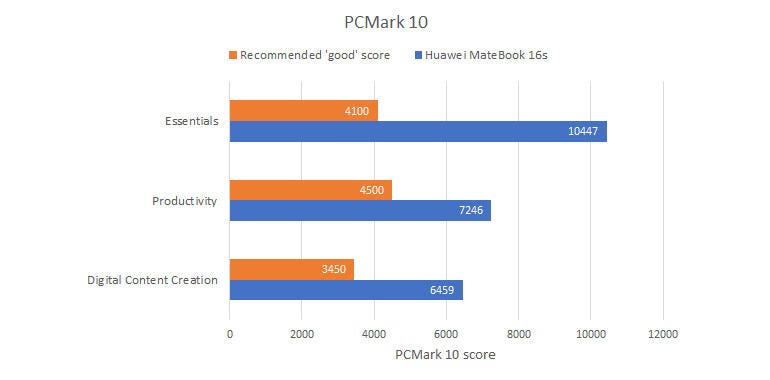
Graphic: Charles McLellan/ZDNet
All in all, the MateBook will cope with most workloads without problems, but what about graphically demanding applications? Especially given the lack of a dedicated GPU?
To investigate, we ran two 3DMark benchmarks: Night Raid, a DirectX 12 test for PCs with integrated graphics (like the MateBook 16s), and Time Spy, a DirectX12 test for gaming PCs (with dedicated GPU). Unsurprisingly, the MateBook 16s performed much better on Night Raid, with 99.6 and 119.7 fps, compared to 11.4 and 9.9 fps in the Time Spy tests. For reference, a laptop with an Nvidia GeForce RTX 3080 gets an average Time Spy score of 12073, which puts the MateBook 16s’ score of 1743 into perspective.
In summary, this laptop does well with games that are not too demanding, but graphically heavy titles are to be avoided.
To test the battery, we ran two tests: one that subjects the MateBook 16s to a heavy workload, involving multiple launches of PCMark 10 interspersed with live streaming over wi-fi; the other with a much less demanding protocol, including web browsing, occasional video viewing, and some word processing.
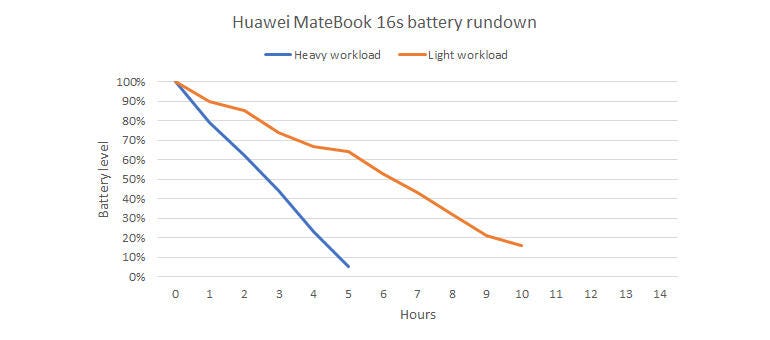
Chart: Charles McLellan / ZDNet.
Depending on the uses, you can therefore expect a range of between 5 and 12 hours approximately. Note that the screen brightness was at maximum during these tests, the battery life will be longer if you reduce the brightness.
Huawei provided us with a 65W USB-C charger with our test model, although the spec sheet mentions a 90W adapter. Starting charging at 16%, it took the charger 40 minutes to reach 50%. 110 minutes will have been necessary to reach 100%.
We didn’t notice any excessive heating emanating from the MateBook 16s, even under heavy workloads. The cooling system includes two fans, vents on the bottom and rear of the machine, and two “extra-large” heat pipes. The computer is also silent.
Here is the thermal image after 5h of heavy workload:
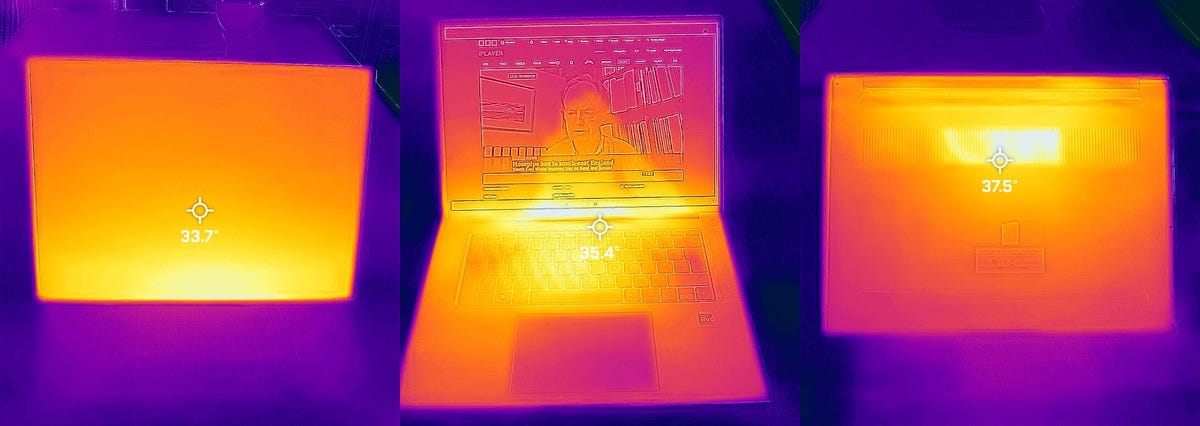
Photo: Charles McLellan/ZDNet
User experience
The Matebook 16S has some new features. The first is AI Camera, which adds options to the webcam such as the ability to change the background (with blur, pre-recorded or custom backdrops). There’s also auto-centering, which keeps people centered in the camera’s field, and vision adjustment, which alters the image to make it look like you’re looking at the webcam rather than the screen.
These functions are more gimmicky than really useful and we would have preferred support for facial authentication via Windows Hello. As it stands, you’ll have to make do with the fingerprint reader built into the power button.
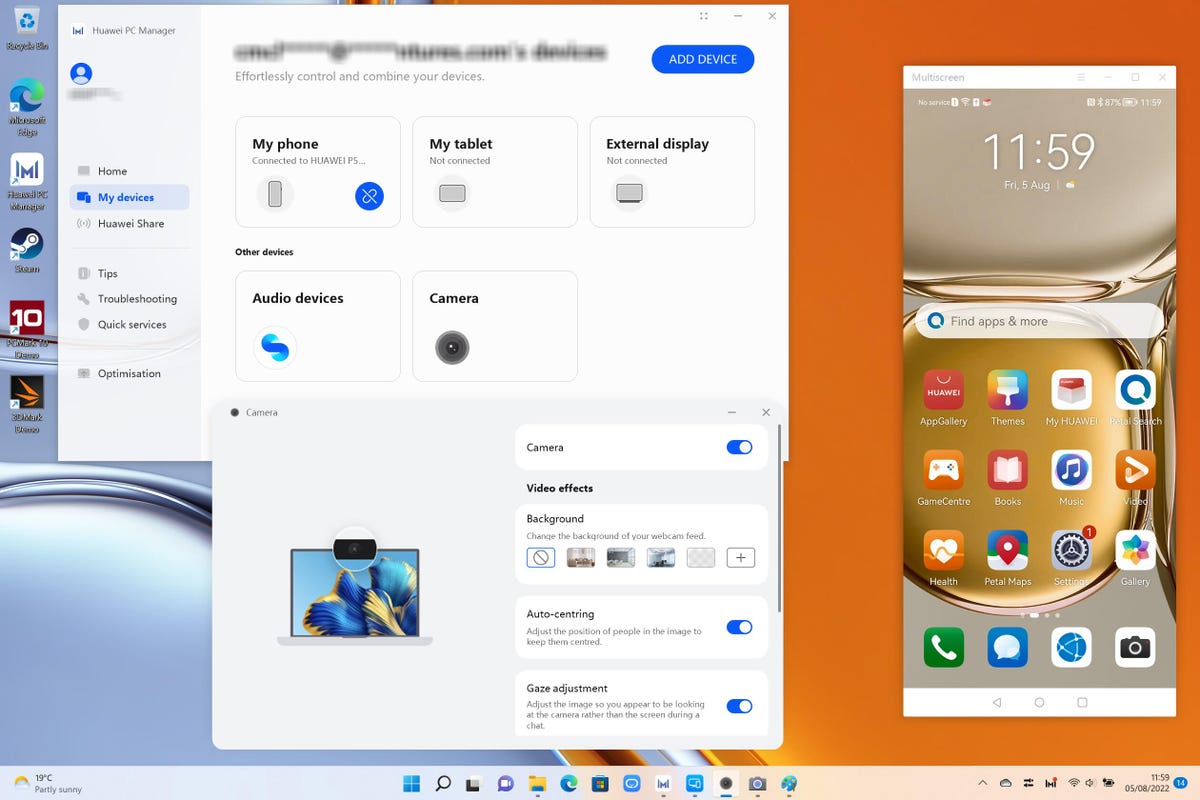
Screenshot: Charles McLellan/ZDNet
Another Huawei-specific feature is the Super Device system, which allows the computer to be connected to other compatible Huawei devices (phones, tablets, screens) to facilitate file sharing. It is necessary to be invested in the Huawei ecosystem to take advantage of Super Device, but if this is your case, it is a useful option.
Findings
If you’re looking for a laptop that combines a great-looking large screen, good design, good build quality, solid overall performance, and some portability, Huawei’s MateBook 16s might be for you. It corrects the problems that we had formulated against the MateBook 16, which nevertheless remains a good option from €1099.99, and is almost an unbeatable product, if we omit two or three small details (absence of SD port and dedicated GPU).
Technical sheet
-
BONE : Windows 11 Home. -
Dimensions : 351mm x 254.9mm x 17.8mm. -
Weight : 1.99 kg. -
Screen : 16-inch IPS, 2520 x 1680 (3:2, 189ppi), 300 nits, 1500:1 contrast, 100% sRGB. -
Colors : 1.07 billion (10-bit color). -
Screen occupancy rate : 90% (announced). -
Angle of vision : 178 degrees. -
Touchscreen : 10-point multi-touch with gesture screen capture. -
Processor : Intel Core i7-12700H. -
Graphic card : Intel Iris Xe Graphics. -
RAM : 16 GB (LPDDR5). -
Storage : 1 TB (NVMe PCIe SSD). -
Battery capacity : 84 Wh. -
Charger : 90W. -
Wireless : Wi-Fi 6E (802.11ax, 2.4GHz, 5GHz, 6GHz). -
Bluetooth : 5.3. -
Connections : 2x USB-A (USB 3.2 Gen1), USB-C, USB-C/Thunderbolt 4, HDMI, 3.5mm audio in/out. -
Keyboard : QWERTY, backlit. -
Fingerprint reader : integrated into the power button. -
webcam : 1080p FHD (above the screen). -
Audio : 4x microphones, 2x speakers. -
Apps : Super Device, Huawei PC Manager, Display Manager, Performance Mode, Huawei Factory Reset. -
In the box : Huawei MateBook 16s, 90W USB-C power adapter, USB-C charging cable, quick start guide. -
Price : 1699.99 €
Alternatives to consider
The benchmark for 16-inch laptops remains the MacBook Pro, which costs a whopping €2,749 for an M1 Pro model with 16GB of RAM and 1TB of SSD. If you’re looking for the ultimate in portability, look to the LG Gram 16 (1.2kg).
Source: “ZDNet.com”
